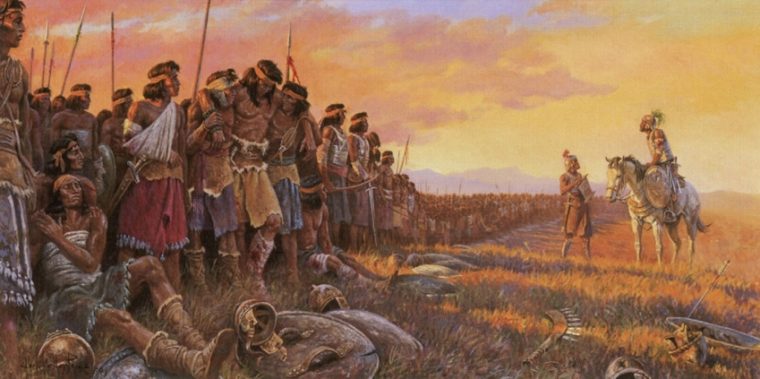The following is from the Isaiah Institute site and was written by Avraham Gileadi Ph.D. Here is a link to the original and I encourage oneClimbs readers to leave comments for Bro. Gileadi there as well if they feel so inclined.

What was it the Lamanite mothers “knew” that convinced them to entrust their young sons to Helaman to lead them in battle against a ferocious enemy that far outnumbered them? Helaman said of them, “They never had fought, yet they did not fear death; and they did think more upon the liberty of their fathers than they did upon their lives; yea, they had been taught by their mothers, that if they did not doubt, God would deliver them. And they rehearsed unto me the words of their mothers, saying: We do not doubt our mothers knew it” (Alma 56:47–48).
Some background to these youths’ firmness of mind may explain the fearlessness their mothers had instilled in their sons: Traditionally, the Lamanites followed the emperor–vassal system of government that had prevailed throughout the ancient Near East. In brief, an emperor such as King Laman or an heir of Laman, the eldest son, ruled over a number of vassal kings and their city-states in his empire. As in the Hittite, Israelite, Assyrian, and Babylonian empires, the emperor was called the “father” of his vassal kings, and they were called his “sons.”
We see an example of this in King Lamoni’s relationship to his “father,” the Lamanite emperor at that time, “who was king over all the land” (Alma 18:9). Although Lamoni was called his “son,” vassal kings were commonly native to the peoples over whom they ruled. Because Lamoni ruled over the land of Ishmael (Alma 17:21), he was therefore most likely himself an Ishmaelite. The “father/sons” relationship between an emperor and his vassal kings, in other words, although purely political and not familial, was nevertheless treated as if it was familial.
The “feast” the emperor had arranged for his “sons,” to which Lamoni was invited (Alma 20:9), typified the traditional or annual celebration when vassal kings came to renew their allegiance to the emperor, bringing with them their tribute monies or taxes. Lamoni’s nonattendance at the feast thus implied that he had rebelled against his emperor. Analogously, the Lamanites’ traditional gripe against the Nephites was that the Nephites had rebelled against Lamanite kingship over all the land, which they considered a Lamanite “right” (Alma 54:17).
As in ancient Near Eastern emperor–vassal covenants, when a vassal king kept the law of the emperor and the people kept of the law of the vassal, the emperor was bound under the terms of the covenant to deliver the vassal and his people from a mortal threat (Avraham Gileadi, “Priesthood, Patriarchy, and Proxy Salvation,” The Last Days: Types and Shadows from the Bible and the Book of Mormon; Deseret Book, 1990; Argon Press, 1998). By thus guaranteeing the emperor’s protection, the vassal acted in the capacity of his people’s proxy savior.
When we transpose the emperor–vassal paradigm to Helaman and his two thousand stripling warriors, we observe some explicit parallels. While Helaman called them his “sons”—because “they were all of them very young”—they called him “father” (Alma 56:46). More than simple youthfulness, however, characterized these Lamanite sons. Not only were they untested for valor physically in battle but also spiritually. They would therefore benefit immensely from Helaman’s serving as their proxy savior under such life-threatening circumstances.
Under the terms of God’s covenant with King David and his heirs, for example, God acted as David’s “father” and David as his “son” (Psalms 2:6–7; 89:20–28). When David kept God’s law and David’s people kept David’s law, God was bound under the terms of his covenant to deliver David and his people from a mortal threat. A classic case of such deliverance occurred in the days of King Hezekiah: When Hezekiah kept God’s law and the people kept Hezekiah’s law, the angel of God slew an invading Assyrian army of 185,000 men (Isaiah 36–38).
In such instances of obtaining God’s protection in the face of mortal danger, David and his heirs not only acted as “sons” to Israel’s God, but also as “father” to the vassal kings of the peoples over whom they ruled. Again transposing this covenantal paradigm to Helaman and his stripling warriors, while God acted as “father” to Helaman and Helaman acted as God’s “son,” Helaman additionally acted as “father” to his “sons,” binding God to protect both him and his young warriors so long as they observed the terms of the Davidic Covenant.
Knowing that Helaman was a righteous high priest according to the holy order of God (Alma 46:6; 49:30), the Lamanite mothers were thus assured of their son’s deliverance under the terms of the Davidic Covenant. Even as Helaman kept God’s law, his two thousand stripling warriors kept Helaman’s law: “They did obey and observe to perform every word of command with exactness; yea, and even according to their faith it was done unto them; and I did remember the words which they said unto me that their mothers had taught them” (Alma 57:21).
Not a single soul perished, therefore, in the two great battles they fought (Alma 56:54–56; 57:19–27). In a similar case, when the sons of Mosiah kept Mosiah’s law and Mosiah kept God’s law (Mosiah 28:1–9), they survived serious mortal threats among the Lamanites. Even when Ammon lay in a swoon and a man raised his sword to kill him, he himself fell dead. Alma thus sums up: “Now we see that Ammon could not be slain, for the Lord had said unto Mosiah, his father: I will spare him, and it shall be unto him according to thy faith” (Alma 19:23).

